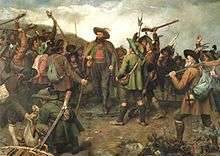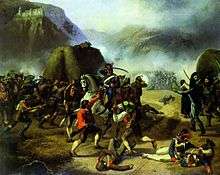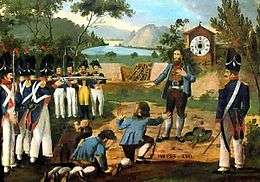Andreas Hofer

Andreas Hofer (November 22, 1767 – February 20, 1810) was a Tyrolean innkeeper and drover, who in 1809 became the leader of the Tyrolean Rebellion against the revolutionary Napoleonic invasion during the War of the Fifth Coalition. He was subsequently captured and executed.
Hofer is still today venerated as a folk hero, freedom fighter and Austrian patriot.
Life

Andreas Hofer was born 1767 in St. Leonhard in Passeier, in the Habsburg crown land of Tyrol. His father was an innkeeper of the Sandhof inn and Andreas followed in his footsteps when he inherited the establishment. He also traded wine and horses in adjacent Northern Italy and learned the Italian language. He married Anna Ladurner. In 1791 he was elected to the Tyrolean Landtag assembly. In German he was known as a Wirt (innkeeper) and thus ever after Sandwirt.
In the War of the Third Coalition against the French he became a sharpshooter and later a militia captain in the Austrian Imperial and Royal Army. After the Austrian defeat, Tyrol was transferred to the Kingdom of Bavaria (France's ally) according to the 1805 Treaty of Pressburg. During the stern measures of Minister Maximilian von Montgelas and the forced recruitment into the Bavarian Army, Hofer became a leader of the anti-Bavarian movement. In January 1809, he was part of a delegation to Vienna to ask Emperor Francis I of Austria for support for a possible uprising. The Emperor gave his assurances and the delegation returned home.
Hofer begun to secretly organize insurrection, visiting villagers and holding councils of war in local inns. Reputedly he was so much on the move that he signed his messages "Andreas Hofer, from where I am" and letters to him were addressed to "wherever he may be". At the same time other leaders organized their own forces elsewhere in the Alps. Hofer became a leader of a militia contingent in the Passeier Valley.
Armed rebellion begins

The Tyrolean Rebellion began on 9 April 1809 in Innsbruck. The previous night, organizers dumped sacks of sawdust into the River Inn as a sign to start the rebellion; floating through the town and down the Inn Valley, it alerted the rebels. Church bells summoned men to fight with muskets and farmyard implements. They soon overran smaller Bavarian garrisons and surprised a column of French infantry that was passing through the area.
On April 11 Tyrolean militia defeated a Bavarian force in Sterzing which led to the occupation of Innsbruck before noon. Though French forces came across the Brenner Pass as a relief and a united French-Bavarian contingent counterattacked the next night, the Tyroleans fought them in the First Battle of Bergisel until Hofer and his allies won on the morning of the 13th. While Austrian forces under General Johann Gabriel Chasteler de Courcelles moved into the Tyrolean capital and installed a provisional government led by Joseph Hormayr, Hofer advanced south, taking Bozen and Trent.
Hopes of a successful rebellion waned when Napoleon defeated the Austrian forces of Archduke Charles of Austria in a series of battles of Teugen-Hausen, Abensberg, Eckmühl, and Ratisbon, whereafter the Austrian troops withdrew from Tyrol and Hofer had to pull back to the mountains. The French Marshal François Joseph Lefebvre took charge of the Tyrolean theatre, and Bavarian and Saxon forces under the command of Karl Philipp von Wrede on May 13 defeated the Austrians in a bloody skirmish at Wörgl. The Bavarians re-occupied Innsbruck on May 19. However, when their French allies left, the rebellion flared up again.
Hofer takes command

Hofer became the effective commander-in-chief of the Tyrolean rebels, with the support of other leaders such as Josef Speckbacher and Father Joachim Haspinger. He commanded a force of Tyroleans approximately 20,000 strong, together with a couple of hundred Austrian soldiers who had joined them after the retreat of the Austrian army.
In the second Battle of Bergisel, from May 25 to May 29 1809, Hofer's troops again defeated the Bavarians, driving them out of the country and retaking Innsbruck on May 30. On May 29 Hofer received a letter from Emperor Francis in which he promised not to sign any peace treaty that would include giving up Tyrol. An Austrian intendant came to rule Tyrol and Hofer returned to his home. However, Napoleon again defeated Austrian troops in the Battle of Wagram on July 6. The Armistice of Znaim ceded Tyrol to Bavaria again. Napoleon sent 40,000 French and Bavarian troops to take over Tyrol and they re-occupied Innsbruck.
After little hesitation, Hofer joined battle again. The French offered a reward for his head. On August 13–14, in the third Battle of Bergisel, Hofer's Tyroleans defeated the French troops of Marshal François Joseph Lefebvre in a 12-hour battle after a downhill charge. The Tyroleans retook Innsbruck.

Hofer declared himself Imperial Commandant of the Tyrol in the absence of the ruler and for two months ruled the land from Hofburg in the name of the Emperor of Austria. He announced new laws and taxes and minted his own coins. He also sent two men to Britain to ask for assistance. On September 29 he received a medal from the emperor and another promise that Austria would not abandon Tyrol.
Hofer's hopes were dashed on October 14 when the Treaty of Schönbrunn again ceded Tyrol to Bavaria. French and Bavarian troops advanced and Hofer retreated to the mountains. Promised amnesty, Hofer and his followers laid down their weapons on November 8. Hofer retired to his home valley.
Final attempt and capture

On November 12, Hofer received false reports of Austrian victories and tried to summon his troops on November 15. This time he had little following and French troops defeated his forces. His subordinate commanders surrendered and urged him to escape over the mountains.
Hofer hid in a hut in the mountains in the Passeiertal and the French announced a reward of 1500 guilders for his head. His neighbor Franz Raffl betrayed him and revealed his hiding place to the authorities. Hofer was captured by Italian troops on January 28, 1810 and was sent to Mantua in chains to face a court martial. (Raffl died impoverished in Bavaria twenty years later.)

Court martial and execution
Officers holding the court martial disagreed on the exact sentence until they received a message from Milan. It was supposedly from the Viceroy, transmitting Napoleon's order to "give him a fair trial and then shoot him." Later Napoleon claimed to Prince Metternich that Hofer was executed against his wishes.
Andreas Hofer was executed by a firing squad on February 20, 1810. He refused a blindfold or to kneel, and gave money to a corporal in charge, telling him to "shoot straight". He gave the order to fire himself. [1] Hofer became a martyr in Germany and Austria and a rallying symbol against the power of Napoleon.
Legacy and monuments
In 1818, his family was given a patent of nobility by the emperor of Austria (he and Anna had 7 children, at least two of whom emigrated to America). In 1823, Hofer's remains were moved from Mantua to Innsbruck, and in 1834, his tomb was decorated with a marble statue. In 1893, a bronze statue of Hofer was erected in Bergisel (Innsbruck). A large painting depicting his arrest hangs in the Palace of Maria Theresa in Innsbruck, and there is an annual open-air play in Meran based on his life. In Meran there is also a monumental statue of him opposite the train station at the beginning of the Via Andreas Hofer, which was erected by Tyrolean nationalists in 1915.
The song Zu Mantua in Banden (today the anthem of the State of Tyrol) tells the story of his tragic fate and execution. His most famous quote: I will not trade my life for a lie
The 1929 German silent film Andreas Hofer is a biopic of his life. Hofer was played by Fritz Greiner.
Literature
- Andreas Hofer an historical novel by Luise Mühlbach, 1871
- Hofer and his wife appear as minor characters in the time travel novel Time for Patriots, whose author is a four times great grandson of the Hofers.
Sources
- Tom Pocock - Stopping Napoleon (2004)
References
- ↑ Tom Pocock. Stopping Napoleon: War and Intrigue in the Mediterranean (Kindle Locations 2357-2359). Thistle Publishing. Kindle Edition.
External links
| Wikisource has the text of the 1921 Collier's Encyclopedia article [[s:Collier's New Encyclopedia (1921)/Hofer, Andreas|]]. |
![]() Media related to Andreas Hofer at Wikimedia Commons
Media related to Andreas Hofer at Wikimedia Commons
- "Andreas Hofer". AEIOU Encyclopedia of Austria. 2009. Retrieved 2009-02-21.
- "Andreas Hofer 1767 - 1810". documentation with photos concerning Andreas Hofer, mainly in German language, some parts in English at sagen.at.
- "Andreas Hofer Biography (German) by". EPOCHE NAPOLEON. Retrieved 2010-10-11.
- "Family tree Andreas Hofer and other Hofer families". Documented with coats of arms, unknown persons, pictures; in Dutch and English. Retrieved 2011-01-15.
- "Tirol in Waffen" (1913/1914), the first feature film on Andreas Hofer, at filmportal.de